Day one – to Sarahan
We’re doing this in the wrong direction and at the wrong time..as usual. The route to Spiti valley from Manali is normally done as a circular circuit, but two of the high mountain passes the road climbs through, Rohtang and Kunzum, haven’t cleared after the winter yet. And considering the name of the less challenging of the two, Rohtang, translates as “piles of dead bodies” it doesn’t seem to be the kind of situation where you should push your luck. So we’ll be driving in towards Spiti the long way instead, and then exiting using the same route. It’s nice to do the trip out-of-season though, less traffic on the roads (which we appreciated once we saw the state of them..) and we had the privilege to be some of the first tourists to reach many of the places this year.
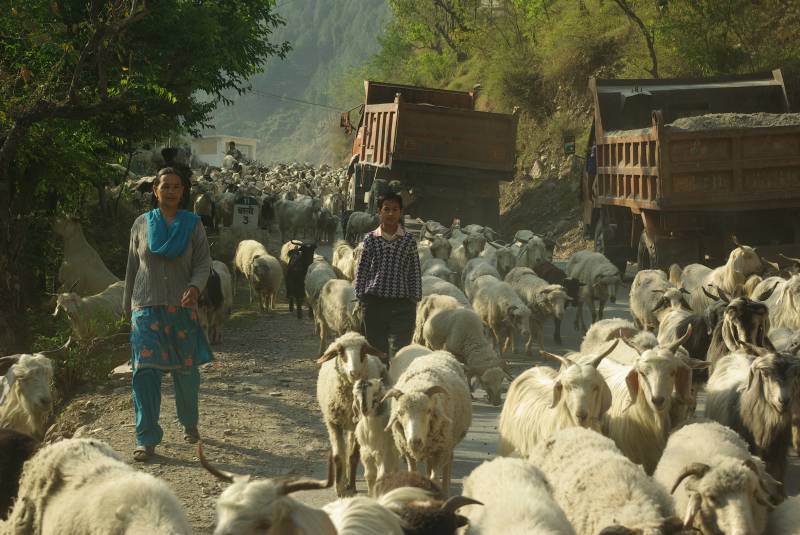
On the road towards Jalori Pass.
In the morning of day one we met our driver Sunil, and settled into the jeep. The road climbed a full kilometer downhill from Manali’s 2000m, before climbing up again to Jalori Pass at 3200m. Apart from all the climbing the drive was pretty relaxing with the jeep occasionally getting stuck in a flock of goats or sheep or behind a mule train. Jalori pass is still well below the snow-line and we did a nice walk in the mixed forest close to the top. Sunil didn’t give us that much instructions before sending us off, but some nice Indian tourists with very little english that we met told us it was a circular walk, which it wasn’t, so we continued on expecting to eventually come back to where the jeep was parked again.. This might be a good moment to thank my dear colleagues back home again for the GPS unit, or we might still be hiking the woods of Jalori Pass! 🙂
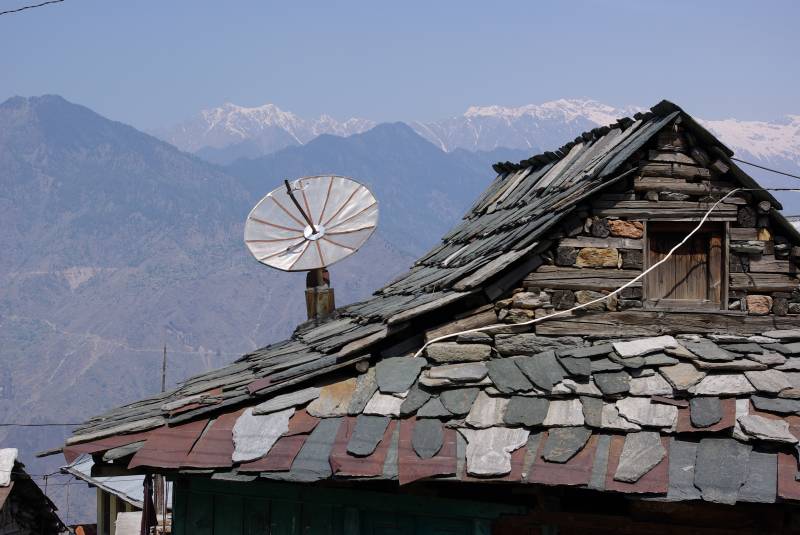
Roof in Sarahan, near the Bhimakali temple.
We spent the night in the village of Sarahan, in a pretty basic hostel (hot water came in buckets left outside the room). In the morning we explored the Bhimakali temple, an elaborate wooden structure which is Sarahan’s no.1 attraction. It’s built mostly in the early 1900’s, but some stone sections are much older and used to be used for human sacrifice until the British came along and stopped all the fun in the 1800’s. One man per decade used to be sent off to the Bhima Kali Hindu deity here, though the goddess now has to make do with a water-buffalo calf, a sheep, a goat, a fish, a chicken, a crab and a spider instead in a complex ceremony held each October…
Day two – to Chitkul

Mule train near Chitkul.
Some of the roads on the way to Sarahan, and from Sarahan to Chitkul, took a bit of getting used to (see pics in the last post). Huge drops by the side, sometimes with a bit of broken railing but more often just with some small white-painted rocks along the side instead. We traveled plenty “relaxed safety” serpentine road back in South America on the last trip so this wasn’t all news, but I still think I maintained a healthy level of terrorizing fear for most of the first day or so.. The brain does funny things..like wanting you to close the car window and lock the door just so the “unpleasant-ness out there can’t get in”.. You get de-sensitized very quickly though – after a couple hours with half a kilometer drop outside the window you don’t react at all when the drop is “just” 50 meters no matter how close to it or how fast the car goes..even though the fall might hurt roughly the same. Sunil seemed a very safe driver though, and after a couple days there was just one spot that might still frighten me; Malling..I’ll get back to Malling later on.. I think the roads we had on the 9 days here were probably worse than the ones we saw in South America last time, though the driving here is better. South America has more of the macho driving style where everyone needs to overtake every other vehicle always and including on blind corners, and of course no-body will allow anyone else to overtake them without a fight as it would be a direct insult to the drivers manliness (..I remember even public buses racing eachother back there!). Indian driving seems slightly more relaxed, at least up in the mountains.
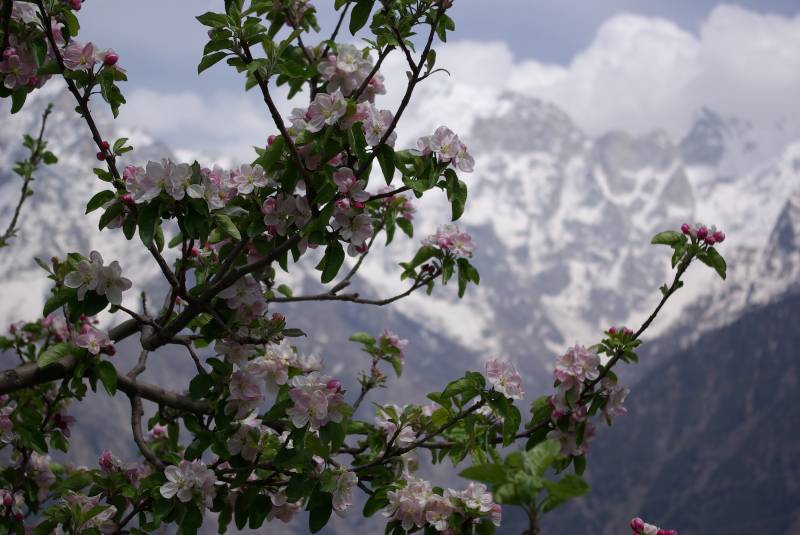
Apple orchard in Kalpa.
Chitkul was a cute little village at 3500m, just where the road up the Baspa river valley ends and the mule tracks take over. Up here the landscape was a bit more barren, and it was pretty cold – partly as the hotel we were staying in was still missing a few walls. It’s the usual method up here – build one or two floors and finish a couple rooms so that you can start to take in guests and make some money to finish the rest of the building! Half the places we stayed had concrete arming bars sticking up from an unfinished roof and lots of “natural light”. As we were among the first people to stay in the hotel in Chitkul the place was very clean anyway 🙂
Along the road down again from Chitkul the next day a Hindu holy man was handing out good luck charms and blessing drivers for the journey down for the small fee of 20 rupees, an absolute bargain I think considering the state of the road!
Day three – to Kalpa
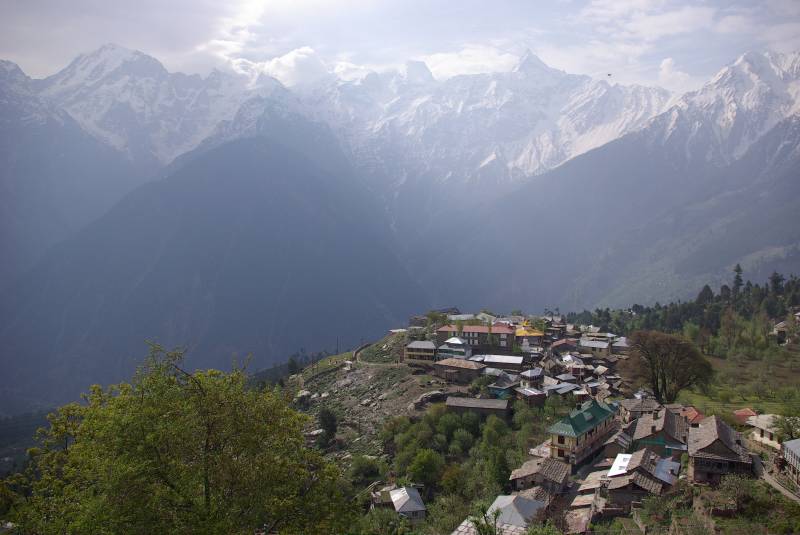
View over Kalpa.
Before continuing to Kapla we stopped in the town Rekong Peo to sort out our Inner Line Permit – some of the areas we planned to visit are very close to the sensitive Tibet border and therefore need a special permit. The area was actually completely off limit to foreigners until 1992. While waiting for the permit for some hours we walked the town a bit and had a lime soda in a roadside restaurant where the menu said “Thanks for patronizing us” as well as promising to “serve you more and more better” if you visit again. Always eager to please Edel went back in with the drinks and asked them to please prepare them again without the extra hay and dirt. The drinks came back out with a lot less fizz so we stocked up on more amoeba medicine in the pharmacy across the street just in case they had used tap water.. We did have breakfast in an even dirtier place on the first day actually..it looked more like a building-site than a restaurant. I was picking hair from my toast+butter and they left a large big lump of dirt on the table that on closer inspection was revealed to contain a plastic bottle of tomato sauce. They also walked right past us down to the river with a couple buckets of plastic garbage and dumped them right in the river as we watched on.. Edel has a theory that any restaurant here with women working in it is a lot cleaner, and it seems to be true so far. There’s always an exception though – in the lovely place we stayed in Kalpa the old gentleman working the kitchen cooked up some fantastic food for us. Kalpa was a really nice spot, apple orchards in bloom and fantastic views towards the Kinner Kailash mountains across the river valley. Kalpa is at 2800m, a full 900 meter climb up serpentine roads from the main road tracing the river valley below.
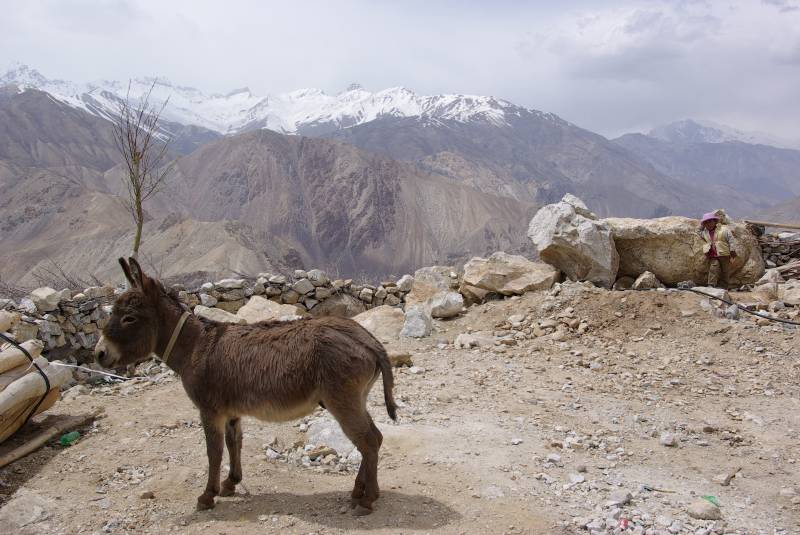
Donkey near Nako village.
Day four – to Tabo
The landscape changed dramatically on the road north leaving the Kinnaur area and movin towards Tabo – the greenery and the trees gone completely as we neared the Spiti valley’s high-altitude desert. The highest points we passed were the tiny villages of Nako at 3600m, where we had a 20 rupee lunch in a roadside stall close to this donkey, and Malling at 3800m. Malling is probably the worst piece of road we have ever seen anywhere. It is in a notorious landslide area, when the guidebook was written they had already tried to make a permanent road there for some decade but at the time you could only scramble across and catch a different vehicle on the other side. Currently the higher of the roads was actually open while a lower road had recently been swallowed up by the mountain again. Sunil, though he had driven the area for 30 years, had to ask for directions along the way to find out which roads were passable as we were the first tour of the year. For a few hundred meters when passing Malling the broken asphalt gives way to loose scree and the road feels very freshly made..the drop on the side is pretty intimidating even after some days getting used to the area. I couldn’t take any photos on the way in as we were giving lift to a military officer at the time (photography inside the Inner Line isn’t officially allowed) but on the way back some days later (..as we had to exit the same route) I caught a couple movies with Edel’s camera.
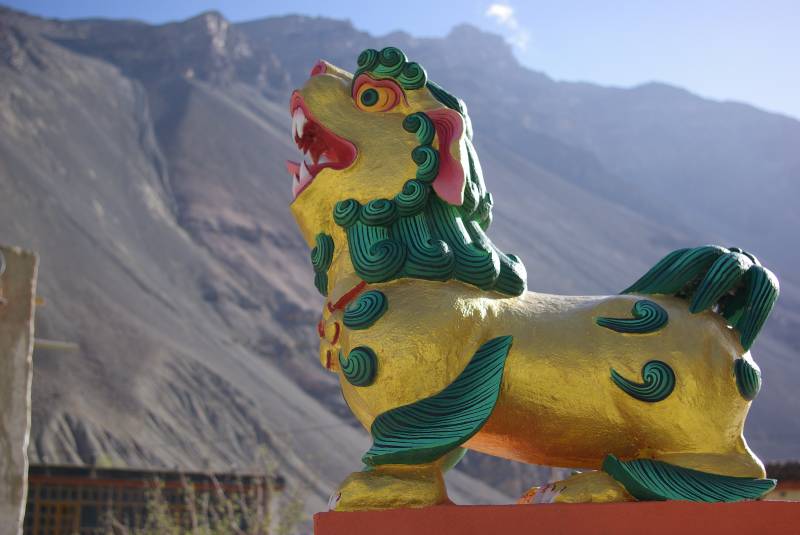
Figure by the Buddhist stupa in Tabo village.
Once reaching Tabo at 3300m we checked in to the Gompa of the local monastery guest house – very basic and no hot water, but the restaurant served some fantastic Tibetan food; momos (dumplings) and thukpa soup. In the morning we explored the ancient Tabo monastery – parts of it are from AD996 and apparently houses some of the best Buddhist art in the Himalayas, though many of the buildings were still locked as the season hadn’t opened yet. It was still nice to explore the outside; ancient ruins and stupas, prayer stones and carvings.